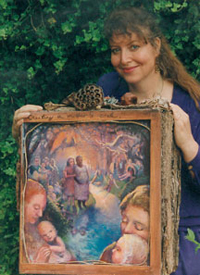Sheryl Cozad

Contact Information:
Sheryl Cozad
Phone:
(405) 360-0087 (evening)
(405) 651-1594 (day)
Email:
Website:
Discipline:
Visual Arts
Participants:
Early Childhood, Elementary, Middle School, Hight School, Adults, Educators, Older Adults, Youth with Disabilities, Adults with Disabilities, At-risk Youth
Settings:
Schools: Pre-k, Elementary, Middle School, High School, Alternative Education
Community Sites: Parks & Recreation Centers, Arts Centers, Childcare Centers, Libraries, Senior Centers, Health Care Facilities
Availability:
Statewide, year-round
Bio:
Sheryl Cozad is a visual artist and college art professor with a Master of Fine Arts in design and painting. Her artwork consists of drawings, paintings, and painted wood pieces in a variety of media including oils, acrylics, watercolor, pastels, and mixed media. Portraits and narrative human figurative pieces are her preferred subject matter. Throughout her career, Cozad has created several hundred portraits as well as more than 50 murals and public works of art, and she has illustrated books and other materials used in the U.S., Canada, South Africa, Iceland, and the United Kingdom. Her experience includes work as an art exhibition curator, a fine arts grant writer and reviewer, a maternal/child healthcare advocate, conference organizer, and a courtroom artist. Currently, Cozad produces several works of art each year, creating work based on personal perspective and often focusing on spirituality and family.
As a college art instructor, Cozad teaches drawing, painting, design, and art history classes. In addition to college art instruction, she has worked with school and community groups, art centers, and hospitals as well as civic and veterans organizations. Over the past 20 years, she has collaborated with children painting around 40 murals on canvas. Two of those murals are displayed permanently in the children’s art room at the Fred Jones Jr. Museum of Art at the University of Oklahoma. Collaborating with adult groups, Cozad has produced several murals on wood. As an Oklahoma Arts CouncilrRoster artist, Norman Arts Council guest artist, and Norman Public Schools visiting artist, she has spent over 3,200 hours working with children in Oklahoma elementary and secondary schools as well as children with special needs including individuals with physical, mental, and emotional disabilities. In addition, she has spent over 1,600 hours working with older adults. Cozad has also presented teacher in-service workshops in more than 30 Oklahoma schools. As an artist-in-residence working with children, she has developed the following curriculum that coordinates with other studies: self-portraits, birds, fish, butterflies, and other insects as well as various animals. Design projects include masks and puppets. Painting projects include all of the above as well as murals on canvas. Inexpensive pencils, oil pastels, watercolor, acrylic, and collage are the major project media. Although she is available at select times year-round, by necessity she must schedule around college teaching obligations.
Learning Goals:
From the Oklahoma State Department of Education's Academic Standards for Visual Arts:
STANDARD 1:
Language of Visual Art: “Presenting”
The student will identify and communicate using a variety of visual art terms.
Through introductory activities, students will:
-
Use appropriate art vocabulary to describe art.
-
Name the art elements and principles of design.
-
Infer meaning from and discuss students' observations of visual and expressive features seen in the environment.
STANDARD 2:
Visual Art History and Culture: “Responding”
The student will recognize the development of visual art from a historical and cultural perspective.
Through background information provided to students during introductory activities which are reinforced during art-making, students will:
-
Describe and place a variety of visual art objects by artist, style and historical and cultural context.
-
Identify how the visual arts are used by artists and designers in today's world.
-
Communicate in-depth knowledge gained through integrated study of a visual art theme.
STANDARD 3:
Visual Art Expression: “Creating”
The students will observe, select, and utilize a variety of ideas and subject matter in creating original works of art.
Through art-making during sessions, students will:
- Create original visual artworks using a variety materials and idea sources.
- Use observation, memory and imagination in creating original works of art.
- Demonstrate safe and proper care of materials.
- Demonstrate basic introductory level understanding of several selected art media and processes including drawing, painting, and design construction.
STANDARD 4:
Visual Art Appreciation: “Connecting”
The student will appreciate and utilize visual art to make interdisciplinary connections and informed aesthetic decisions.
Through the art-making experience, students will:
-
Demonstrate appropriate behavior during creative processes.
-
Demonstrate proper respect for personal artwork and the artwork of others.
-
Demonstrate thoughtfulness and care in completion of artworks.
-
Make learning connections between visual art and other disciplines.
